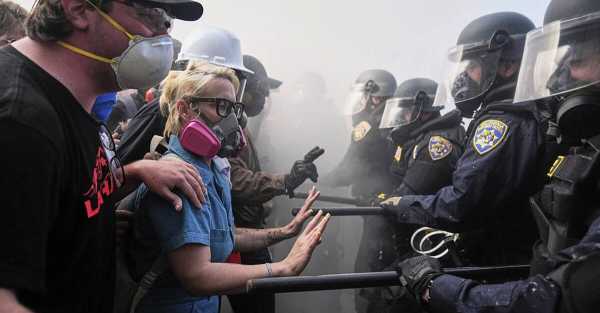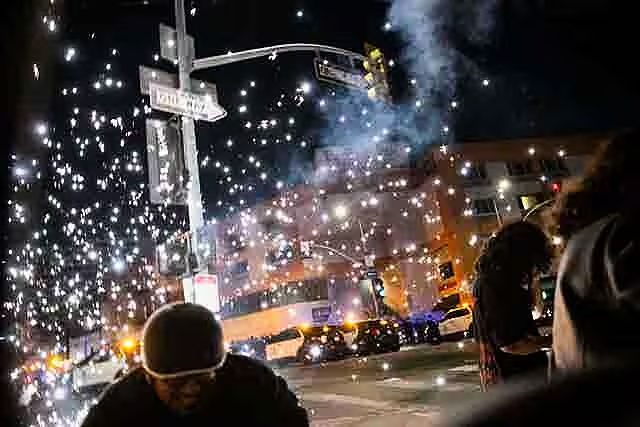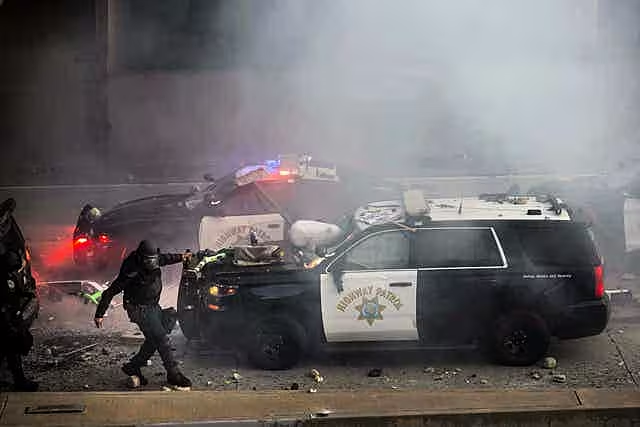
Tensions escalated in Los Angeles on Sunday as thousands of protesters took to the streets in response to US President Donald Trump’s decision to deploy the National Guard.
They blocked a main road and set fire to unmanned vehicles, while law enforcement officers used tear gas, rubber bullets and stun grenades to control the crowd.
By evening, many protesters had dispersed and police declared the gathering illegal, heralding a law enforcement invasion and arrests of people who refused to leave.
Some of those who remained threw objects at police from behind a makeshift barrier that blocked the width of the street, while others hurled concrete chunks, rocks, electric scooters and fireworks at California Highway Patrol officers and their vehicles parked on the closed southbound 101 Freeway.
The police officers hid under the overpass.

Sunday’s protests in Los Angeles, a sprawling city of four million people, were concentrated in a few blocks downtown. It was the third and most intense day of demonstrations against Mr. Trump’s immigration crackdown in the region, as the arrival of about 300 Guard troops sparked anger and fear among many residents.
The Guard was deployed specifically to protect federal buildings, including the detention center where protesters were concentrated.
Los Angeles Police Chief Jim McDonnell said officers were “overwhelmed” by the remaining protesters. He said they included the usual agitators who show up at demonstrations to cause trouble.
Dozens of people were arrested over the weekend of protests. One was detained Sunday for throwing a Molotov cocktail at police, and another for driving a motorcycle into a line of officers.
Mr Trump responded to Mr McDonnell on Truth Social, calling on him to arrest masked protesters.
“It looks really bad in LA. BROUGHT IN THE TROOPS!!!” he wrote.
Since the morning, troops have stood shoulder to shoulder, carrying long guns and shields, while protesters have chanted “shame” and “go home.”
After some of them approached the guards, another group of uniformed officers moved towards the group, firing smoke bombs into the street.
Minutes later, Los Angeles police used grenades to disperse protesters they said had gathered illegally.
Most of the group then blocked traffic on the 101 Freeway until patrol officers cleared the roadway later in the day.
Nearby, at least four Waymo self-driving cars caught fire, sending large plumes of black smoke into the sky and the electric vehicles repeatedly exploding as they burned. By evening, police had issued an unlawful assembly citation, shutting down several blocks of downtown Los Angeles.

In the evening, flash-bang grenades exploded every few seconds.
Democratic Governor Gavin Newsom demanded in a letter on Sunday afternoon that Mr. Trump recall the Guard members, calling their deployment a “serious violation of state sovereignty.” He was in Los Angeles meeting with local law enforcement and officials.
The deployment appears to be the first time in decades that a state’s National Guard has been activated without a request from the governor, a significant crackdown on those who have tried to thwart the administration’s mass deportation efforts.
Mr. Newsom and Los Angeles Mayor Karen Bass blamed the growing violence of the protests on Mr. Trump’s decision to deploy the Guard, calling it a move aimed at escalating tensions. They both urged protesters to remain peaceful.
“What we’re seeing in Los Angeles is chaos created by the administration,” she said at an afternoon news conference. “This is about a different agenda than public safety.”
But Mr McDonnell, the Los Angeles police chief, said the protests were following the same pattern as episodes of civil unrest, and the situation had escalated on the second and third days.
He rejected Trump administration claims that Los Angeles police failed to assist federal authorities when protests erupted on Friday following a series of immigration raids.

He said his department responded as quickly as it could and was not given advance notice of the raids, so was not prepared for the protests.
Meanwhile, Mr. Newsom has repeatedly said that California authorities have the situation under control.
He mocked Mr. Trump for posting a congratulatory message to the Guard on social media before the troops arrived in Los Angeles, and said on MSNBC that Mr. Trump never raised the Guard deployment during a phone call Friday. He called Mr. Trump a “stone-cold liar.”
The warnings did not stop the administration.
“Newsom’s claims that there were no problems in Los Angeles before President Trump intervened are a blatant lie,” White House press secretary Abigail Jackson said in a statement.
The National Guard’s arrival follows two days of protests that began Friday in Los Angeles and spread Saturday to Paramount, a predominantly Latino city south of the city, and neighboring Compton.
Federal agents arrested immigrants in a trendy Los Angeles neighborhood, a Home Depot parking lot and several other locations on Friday.
The next day, they staged a protest outside the Department of Homeland Security office near another Home Depot in Paramount, attracting protesters who suspected another raid.
Federal authorities later said there was no enforcement action at Home Depot.
The number of immigration arrests in the Los Angeles area has surpassed 100 in a week, according to federal authorities. More people have been arrested during protests, including a prominent labor leader who was charged with obstructing law enforcement.
The protests have not reached the scale of past demonstrations that have seen the National Guard deploy to Los Angeles, including the Watts and Rodney King riots and the 2020 protests against police violence, during which Mr. Newsom requested federal troop assistance.
The last time the National Guard was deployed without the governor’s permission was in 1965, when President Lyndon B. Johnson sent troops to protect a civil rights march in Alabama, according to the Brennan Center for Justice.
In a directive on Saturday, Mr. Trump invoked a provision of the law that allows him to deploy federal troops in the event of “an insurrection or threat of insurrection against the authority of the United States Government.”
He said he had authorized the deployment of 2,000 National Guard members.
On Sunday, as he prepared to board Air Force One in Morristown, New Jersey, Mr. Trump told reporters that there were “violent people” in Los Angeles “and they’re not going to get away with this.”
Asked if he planned to send American troops to Los Angeles, Mr Trump said: “We will have troops everywhere. We will not allow that to happen to our country.” He did not elaborate.
About 500 Marines stationed at Twentynine Palms, about 125 miles (200 kilometers) east of Los Angeles, were in a “ready to deploy” state on Sunday afternoon, according to U.S. Northern Command.
Sourse: breakingnews.ie